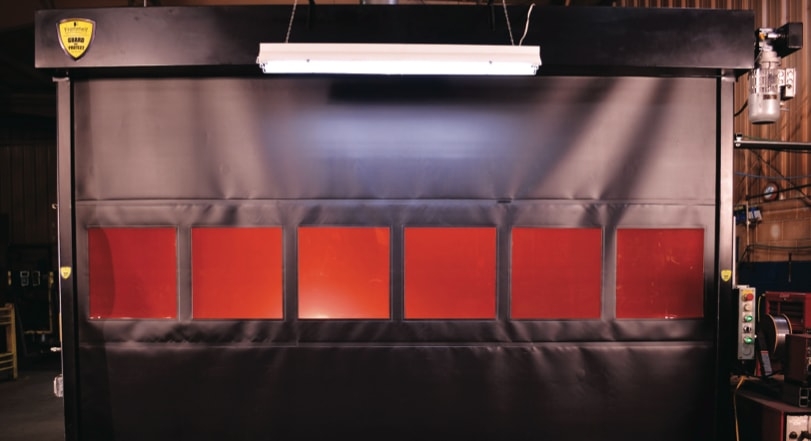
Automated barrier doors are an ideal light curtain alternative
September 18, 2017
By Eric Esson

Sep. 18, 2017 – Working efficiently doesn’t mean safety needs to be sacrificed. In fact, more and more facility managers are learning that the latest technology actually improves safety along with efficiency.
Machine guarding is one of those areas that safety and efficiency don’t go hand in hand. Workers trying to get around safety measures in an attempt to increase throughput is why machine guarding — specifically related to robotic welding 29 CFR 1910.212 — is always in the top 10 most frequently cited OSHA standards violated every year. It’s also one of the most confounding aspects of manufacturing plants with risks in the interaction between automated processes and employees at points of operation. So where does a facility manager start?
Determining risk
When performing a proper risk assessment, which is now mandatory when adding a new machine or process thanks to ANSI/RIA R15.06, point-of-operation guarding is probably the most involved aspect. It is easy to place perimeter guarding around the entire process. However in most situations, a machine operator needs to interact with the process by loading or unloading materials (components to be welded) and “running” the machine.
This point-of-operation is where things can get tricky. Many details must be considered when it comes to this area, including the layout or design of the process, the limits of the system and properly identifying all associated hazards. Using the distance formula as identified in OSHA guidelines can help determine the best guarding device. Per this formula, the safeguarding product has a prescribed location based on a number of factors, including secondary hazards that might harm a machine operator.
Presence-sensing devices
Light curtains, laser scanners and other presence-sensing devices are a commonly used and widely accepted method of machine guarding in manufacturing facilities from Tier 1 automotive to small machine shops and fabrication facilities. The automated process ceases once the safety device’s infrared beam is tripped.
In many instances, these devices provide acceptable safety. However, they’re not always the best choice in all applications, especially after a risk assessment is performed.
Limiting hazard exposure
Light curtains may be the right choice in some applications, as they can limit exposure to the hazard and reduce risk. But, a fast-acting automated barrier door or roll-up curtain may be the better choice because they can eliminate exposure to both the dangerous movement of the machine and secondary hazards produced by the process, potentially eliminating risk and the severity of exposure.
Coupled with safety interlocks (up to PLe per EN ISO 13849-1 when integrated properly), automated barrier doors and roll-up curtains offer increased protection for point-of-operation guarding. Not only do they restrict access to the process, they also contain secondary hazards such as smoke, flash, splash, mist or flying debris associated with automated welding operations by placing a barrier between the operator and machine movement. These guards are an ideal alternative to light curtains and other presence-sensing devices.
Additional benefits of automated barrier doors
Due to the nature of a properly interlocked automated barrier door, certain aspects of OSHA’s safety distance formula become moot because there is no depth penetration factor, allowing the safeguard to be placed much closer to the hazardous area. This correlates to less space being dedicated to a safety zone and directly results in reducing the manufacturing cell’s footprint. This space savings is a huge benefit in most facilities and it means workers can actually stand closer to the automated operation than with light scanners.
The smaller safety zone may also make for a better ergonomic situation for the machine operator by limiting required motion and help increase productivity, which is essential in today’s competitive market.
The elimination of accidental entry into the cell is another benefit of interlocked automated barrier doors. Because they provide safeguarding that can be seen — unlike invisible infrared beams — the opportunity for accidental work stoppage is greatly reduced. The physical separation they provide is a clear visual indicator that the machine operator needs to be on task.
Regardless of the safety device that ends up being selected for machine guarding, facility managers need to remember to perform a proper risk assessment. When it comes to material handling operations in industrial facilities, physical barriers can offer additional protection and are generally going to improve productivity.
Eric Esson is the machine guarding global sales manager for Rite-Hite.
This column was originally published in the September 2017 issue of Manufacturing AUTOMATION.